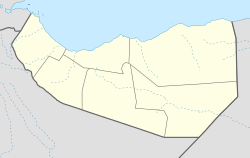History
Ruguda was a well known landmark to navigators and legendary Arab explorer Ahmad ibn Mājid wrote of Ruguda and a few other notable landmarks and ports of the northern Somali coast, including Berbera, the Sa'ad ad-Din islands aka the Zeila Archipelago near Zeila, Siyara, Maydh, Alula, El-Sheikh, Heis and El-Darad. [7]
John Hanning Speke, an English explorer who made an exploratory expedition to the area in an attempt to reach the Nugaal Valley, described the port town: [8]
On the 21st October, 1854, Lieutenant Speke, from the effects of a stiff easterly wind and a heavy sea, made by mistake the harbour of Rakudah. This place has been occupied by the Rer Dud, descendants of Sambur, son of Ishak. It is said to consist of an small fort, and two or three huts of matting, lately re-erected. About two years ago the settlement was laid waste by the rightful owners of the soil, the Musa Abokr, a sub-family of the Habr Tal Jailah.
— Sir Richard Francis Burton, First Footsteps in East Africa, Or, An Exploration of Harar
This page is based on this
Wikipedia article Text is available under the
CC BY-SA 4.0 license; additional terms may apply.
Images, videos and audio are available under their respective licenses.

